
Phragmipedium is a genus of the Orchid family (Orchidaceae) and the only genus comprised in the tribe Phragmipedieae and subtribe Phragmipediinae. The name of the genus is derived from the Greek phragma, which means "division", and pedium, which means "slipper". It is abbreviated 'Phrag' in trade journals.
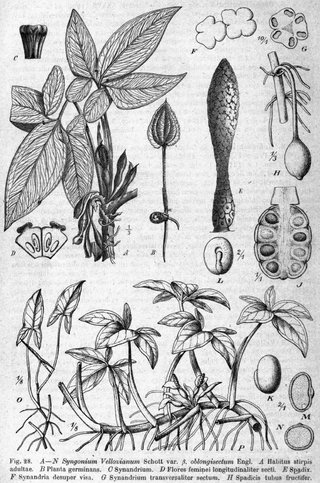
Syngonium is a genus of flowering plants in the family Araceae, native to tropical rainforests in southern Mexico, the West Indies, Central and South America. They are woody vines growing to heights of 10–20 m or more in trees. They have leaves that change shape according to the plant's stage of growth, and adult leaf forms are often much more lobed than the juvenile forms usually seen on small house plants. The scientific name of the genus comes from the Greek words σύν and γονή and refers to the fused ovaries of female flowers.

Cylindrolobus is a genus of orchids with about 80 species that grow in New Guinea, Wallacea, Southeast Asia, southern China, and India.

Trichoglottis, commonly known as cherub orchids or 毛舌兰属 , is a genus of flowering plants in the family Orchidaceae. Orchids in this genus are epiphytic plants with thick roots, relatively thick, fibrous stems and many large, thick, leathery leaves arranged in two ranks. The flowers are usually small and yellowish with light brown or purple markings. The flowers have broad sepals, narrower petals and a labellum which has three lobes and is often hairy. There are about 85 species distributed from tropical and subtropical Asia to the north-western Pacific. Most species grow in rainforest.
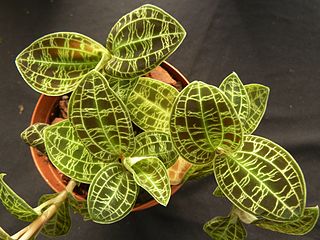
Macodes is one of a few genera of the orchid family known as jewel orchids. These terrestrial orchids grows in the rainforest floor of Southeast Asia with high humidity and low light. They can also be found in New Guinea, Vanuatu, the Solomon Islands and the Ryukyu Islands. The plant is cultivated for the veined leaves, unlike most other orchids that are valued for the flowers.

Goodyera oblongifolia is a species of orchid known by the common names western rattlesnake plantain and giant rattlesnake plantain. It is native to much of North America, particularly in the mountains of the western United States and Canada, from Alaska to northern Mexico, as well as in the Great Lakes region, Maine, Quebec and the Canadian Maritime Provinces.

Goodyera pubescens, the downy rattlesnake plantain, is one of the most common orchids native to eastern North America. It is found from Florida to Nova Scotia, west to eastern Oklahoma, Minnesota and Ontario.

Cattleya maxima is a species of orchid in subfamily Epidendroideae found from Ecuador to Peru.
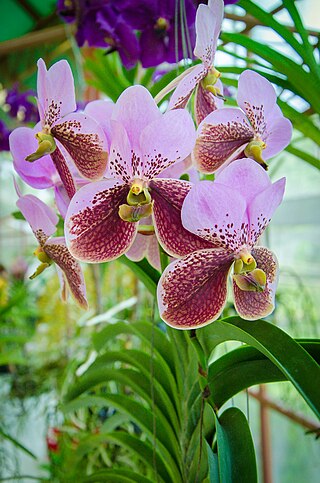
Vanda sanderiana is a species of orchid. It is commonly called Waling-waling in the Philippines and is also called Sander's Vanda, after Henry Frederick Conrad Sander, a noted orchidologist. The orchid is considered to be the "Queen of Philippine flowers" and is worshiped as a diwata by the indigenous Bagobo people.
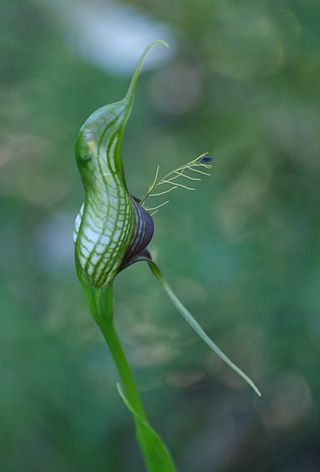
Pterostylis barbata, commonly known as the western bearded greenhood or bird orchid is a species of orchid endemic to the south-west of Western Australia. Flowering plants have a rosette of leaves at the base of the plant and a single translucent white flower with dark green veins on a flowering stem with up to 20 stem leaves. It is one of a number of bearded orchids, some of which have yet to be formally described, all of which have a distinctive feather-like labellum.

Calochilus, commonly known as beard orchids, is a genus of about 30 species of plants in the orchid family, Orchidaceae. Beard orchids are terrestrial herbs with a single leaf at the base of the plant, or no leaves. Their most striking feature is a densely hairy labellum, giving rise to their common name. Beard orchids, unlike some other Australian orchids, do not reproduce using daughter tubers, but self-pollinate when cross-pollination has not occurred. Most species occur in Australia but some are found in New Zealand, New Guinea and New Caledonia.

Pomatocalpa, commonly known as bladder orchids, or 鹿角兰属 , is a genus of about twenty five species from the orchid family, Orchidaceae. Plants in this genus are epiphytes or lithophytes with thick, leathery leaves and a large number of small flowers with a three-lobed labellum. There are about twenty five species found from tropical and subtropical Asia to the south-west Pacific.
Rhomboda polygonoides , commonly known as the velvet jewel orchid, is a species of terrestrial orchid that is native to New Guinea, New Caledonia, the Solomon Islands and north-eastern Queensland. It has between five and nine narrow egg-shaped, purplish green leaves with a central white stripe and up to fourteen green and white resupinate flowers with the lateral sepals held nearly horizontally.

Geodorum densiflorum, commonly known as pink nodding orchid or 地宝兰 , is a plant in the orchid family and is native to areas from tropical Asia to eastern Australia and some Pacific Islands. It is a terrestrial orchid with broad, pleated, dark green to yellowish leaves and up to and twenty pale pink flowers with dark red veins on the labellum. It grows in wetter habitats including rainforest, woodlands, grasslands and swamps.
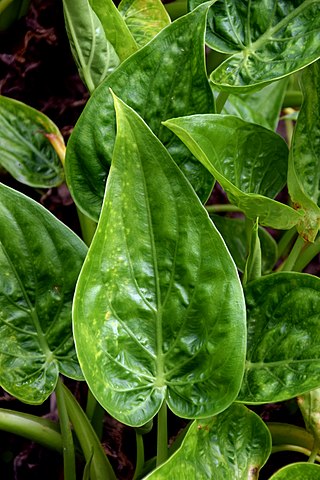
Alocasia cucullata is a species of flowering plant in the arum family known by the common names Chinese taro, Chinese ape, Buddha's hand, and hooded dwarf elephant ear. It is kept as an ornamental plant.

Macodes petola is a species of jewel orchid endemic to Southeast Asia including in Malaysia, New Guinea, Vanuatu, the Philippines and Sumatra. Flowers from this species are small, with red-brown petals with a yellow edge and white lip and appear in the winter months. Unlike the flower, the foliage on this plant is ornate and renders this plant of interest to botanical collectors. However, this plant is currently considered vulnerable with restricted trade due to risk of over collection and use as a stimulant in Borneo traditional herbal medicine. M. petola is found growing under varying conditions in the wild. The plant can be found growing at heights between 300-1600m above sea level typically in forest habitats with high humidity.
Salix delavayana is a shrub or small tree from the genus willow (Salix) with mostly 3 to 8 centimeters long leaf blades. The natural range of the species is in the south of China and in Tibet.
Salix dibapha is a shrub from the genus of willow (Salix) with mostly 4 to 6 centimeters long leaf blades. The natural range of the species is in China.

Corybas hatchii is a species of terrestrial orchid endemic to New Zealand. It has a solitary rounded leaf, often flecked with maroon, and a single pale green and maroon flower with long, threadlike lateral sepals and petals.

Batesanthus purpureus is a species of plant in the Apocynaceae family. It is native to the Cameroon, the Central African Republic, Democratic Republic of the Congo, Gabon, Guinea, Ivory Coast, Liberia, and Nigeria. Nicholas Edward Brown, the botanist who first formally described the species, named it after its purple flowers.

















